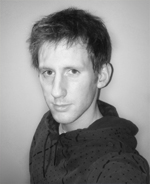
Organisations
Supervisors
Software Packages
Tom Poole
Imperial College research.
Introduction
Tom's research is supervised by Prof. Matthew Foulkes, Dr. James Spencer and Prof. Peter Haynes with the support of the EPSRC funded Centre for Doctoral Training in Theory and Simulation of Materials at Imperial College London.
The correlation of dynamics via stochastic noise
The videos in this section demonstrate an important feature of the correlated sampling quantum Monte Carlo method currently under development: a stability against divergence of two distinct stochastic trajectories sharing a common noise. It can be shown that when the influence of the shared noise exceeds a specific frequency, the trajectories coalesce exponentially fast in time and remain similar.
The divergence of classical dynamics
The video below shows two classical balls rolling without friction in a potential landscape. The balls are initially coincident with a small difference in their starting velocities, resulting in an approximately exponential divergence in their trajectories.
The convergence of stochastically correlated classical dynamics
This video features a simulation with the same initial conditions as the previous, where a common stochastic noise has been introduced to the dynamics. Periodically both balls are stopped then restarted with identical, randomly selected velocities. When both balls occupy the same convex region of the potential they are driven together, with the influence of the stochastic noise acting as a damping term.
The two trajectories will converge even when the starting conditions of each ball are very different. The video below shows that, despite a large separation, once the random kicks cause both balls to share a minimum in the potential the paths coalesce rapidly.
Correlated dynamics in diffusion Monte Carlo
Correlating trajectories in such a manner is particularly well suited to the sampling algorithm of diffusion Monte Carlo. Here electronic configurations evolve according to Langevin dynamics, consisting of a purely stochastic diffusive component and a drift component playing a role analogous to classical acceleration. Coupling configurations via their diffusive motion results in convergence properties similar to that of the classical systems shown above. The video below represents correlated Langevin sampling of a function (shown inverted) from two different starting points.
Diffusion Monte Carlo molecular dynamics
Below is a video displaying a molecular dynamics simulation driven by forces obtained from algorithmic differentiation of diffusion Monte Carlo calculations. The chemical reaction shown is the dimerisation of borane, where pink spheres repesent boron atoms and white spheres represent hydrogen. A dimer is formed by the creation of two 3-center 2-electron bridges, known as banana bonds, between the two borane molecules.